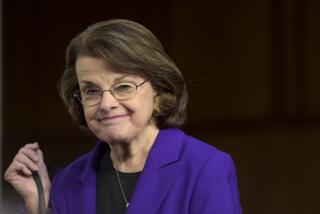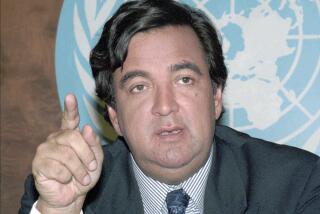Harold Stassen; Ex-Minnesota Governor Sought GOP Nod for Presidency 9 Times
Former Minnesota Gov. Harold E. Stassen, the onetime âboy wonderâ of Republican politics who became a perennial unsuccessful aspirant for his partyâs presidential nomination, died Sunday. He was 93.
Stassen died in the Bloomington, Minn., retirement community where he had lived for the last few years, said his granddaughter, Rachel Stassen-Berger.
Blithely ignoring opinions that he was making a joke of himself, Stassen threw his hat in the ring nine times beginning in 1948 and ending--finally--in 1992. Asked once why he was announcing yet another run for the GOP nomination, he said simply, âBecause I feel itâs my responsibility.â
In 1971, he said, âTo me, the election in itself has never been the important thing. What are more important are the forces you set in motion, the discussion and the debate you generate.â
In 1991, as he made his ninth and final presidential bid by entering the nationâs first primary in New Hampshire, the former Minnesota governor looked back and--despite all the defeats--said, âItâs really been a winning life.â
That year, he won a single delegate in the Minnesota primary, but released even that one to vote for any candidate and received no votes at the nominating convention.
He made only one more ill-fated bid for office, running for U.S. senator from Minnesota. In 1996, at the age of 89, he offered to serve as the vice presidential running mate for Bob Dole. That offer, too, was rejected.
âAs Minnesotans, we can be proud of a statesman who never gave up his fight for a better state, a better country and a peaceful world,â Minnesota Gov. Jesse Ventura said Sunday.
Stassen was elected governor of Minnesota three times, was one of the framers of the United Nations charter, was president of the University of Pennsylvania, was President Dwight D. Eisenhowerâs disarmament advisor and a successful Philadelphia lawyer.
But he never became president of the United States.
Tall, Lonely Figure
He did not even win his partyâs nomination, although he always thought that uncommitted delegates would turn to him in the event of a deadlock. At convention after convention, he was a tall, lonely figure in hotel hallways, going from room to room to shake hands and explain his policies.
He never was able to rekindle the fire he had ignited in 1940, when, as the dynamic 33-year-old governor of Minnesota, he delivered an electrifying keynote address to the GOP convention that nominated Wendell L. Willkie.
That speech propelled the intense young Stassen into the national political limelight. He challenged his party and the American people to stand shoulder to shoulder in the spirit of the pioneers. He got a thunderous ovation.
He was too young then to be a presidential candidate.
But as he grew older, events seemed to push him aside. He was to blame his political eclipse on his futile efforts to have Eisenhower dump Vice President Richard M. Nixon from the reelection ticket in 1956.
âBeginning then,â he subsequently told an interviewer, âI got no speaking engagements through the party and people shunned me.â
âI Tried, You Knowâ
After Watergate and the resignation in disgrace of the man he had opposed, Stassen said, âMy biggest disappointment was that I was not able to save the country from the tragedy of Richard Nixonâs candidacy. I tried, you know.â
Stassen was the son of Scandinavian immigrants. He was born on a truck farm outside Minneapolis on April 13, 1907. Even as a boy, he was hard-driving and persistent, finishing elementary school in only four years and graduating from high school at age 15.
He managed the family farm during his fatherâs illness, then entered the University of Minnesota in 1922. He worked as a Pullman porter for a time to help finance his education. After receiving his B.A. degree in 1927, Stassen entered the University of Minnesota law school and worked so hard that he undermined his health. He got his law degree in two years.
He wasted no time entering politics and won election as Dakota County attorney, an office he held from 1930 to 1938, when he went up against incumbent Minnesota Gov. Elmer A. Benson and beat him to become, at 31, the youngest governor ever elected in any state.
Keynote Speech
Then came his exciting keynote speech and it seemed that he was almost certainly on his way to the White House.
But World War II erupted. In 1943, during his third two-year gubernatorial term, he resigned to go on active duty in the Navy. He served in the South Pacific as Adm. William E. Halseyâs flag secretary, was under fire, was decorated and was promoted to captain.
Before the war ended, he was granted leave to be a representative to the United Nations conference in San Francisco, where he led the losing fight in the American delegation to keep the power of veto out of the U.N. charter.
At warâs end, he returned to active duty with the Third Fleet in Tokyo Bay, directing the removal of 13,000 American POWs from Japanese prison camps to hospital ships.
He returned to civilian life and again became active in Minnesota politics. In December 1946, he was the first to announce as a candidate for the 1948 Republican presidential nomination.
Stassen campaigned hard for a year. He was perceived as a progressive Republican who supported collective bargaining for labor, but opposed the closed shop. In foreign affairs, he believed in international cooperation, not isolationism.
Eisenhowerâs Year
He did well in the early primaries, but was beaten by Sen. Robert A. Taft in Ohio, then by Thomas E. Dewey in Oregon. Dewey won the nomination, only to be defeated by President Harry S. Truman.
Stassen was offered the presidency of the University of Pennsylvania and took it.
He made another try for the GOP nomination in 1952, when he headed the Minnesota delegation. But it was Eisenhowerâs year, and Stassen ended up throwing his support behind the war hero and against Taft. As a reward, President Eisenhower made him chairman of the Foreign Operations Administration, a post from which Stassen pressed for more economic aid to other countries.
In 1955, Stassen became Eisenhowerâs disarmament advisor. It was in that capacity (as âsecretary of peaceâ) that Stassen worked with the president at the 1955 summit conference in Geneva to develop an âopen skiesâ policy.
âWe developed that approach in Geneva to open up relations between the countries, to open the skies,â he reflected 20 years later. âI think that summit meeting historically will prove to be a major turning point between a growing danger or a devastating nuclear world war. . . .â
Political Blunder
But Secretary of State John Foster Dulles, Vice President Nixon and others in the administration were less inclined to accommodate Russia on the issue and in 1957 at a U.N. Disarmament Commission subcommittee meeting in London, Stassen made a political blunder.
Without consulting Americaâs allies, he disclosed to the Russians a âtalking paperâ proposal that fissionable material produced in the future be devoted only to peaceful purposes. This angered the British, who complained directly to Eisenhower that such a plan would prevent the British from attaining the nuclear strength they believed was necessary.
Eisenhower reprimanded Stassen for causing him âacute embarrassment.â Dulles went to the conference to deliver the U.S. position personally.
With his effectiveness thus impaired, Stassen resigned in 1958.
By that time he had already run afoul of party regulars with his campaign to have Massachusetts Gov. Christian Herter replace Vice President Nixon on the 1956 ticket. Major Republican figures rallied behind Nixon, and Herter finally nominated Nixon at the convention. Stassen surrendered and seconded it.
Pennsylvania Politics
Stassen made a couple of other stabs at regaining his initial political momentum. In 1958 he ran for governor of Pennsylvania, but was buried in the Republican primary.
The following year, he tried for the Philadelphia mayorâs office. That time he won the GOP nomination, but lost to the incumbent Democratic mayor, Richardson Dilworth.
In 1960, he pushed a Nelson A. Rockefeller draft in an effort to deprive Nixon of the GOP presidential nomination. Nixon won the nomination, but lost the election to John F. Kennedy.
In 1964, Stassen ran for president again and two years later made another try for Pennsylvania governor.
In 1967, when he proclaimed himself a candidate for the 1968 Republican presidential nomination, someone asked him what constant losing did to a man.
âIt keeps you humble,â he replied, then calmly went ahead with his attempt to win the nomination on a platform to de-escalate the war in Vietnam.
He Kept Trying
He continued to try, prompting an occasional funster to launch a facetious âStop Stassenâ campaign. He took to wearing a toupee, perhaps to maintain as well as he could the image of the young, fiery Minnesota governor who had brought a convention to its feet in 1940.
He was hardly a failure. His Philadelphia law practice was highly successful. He could look back upon a career that included negotiating many important foreign agreements, perhaps more, he commented in 1976, âthan any man alive.â
Widowed in October by the death of his wife of 70 years, Esther, Stassen is survived by a son and a daughter, seven grandchildren, and four great-grandchildren.
More to Read
Get the L.A. Times Politics newsletter
Deeply reported insights into legislation, politics and policy from Sacramento, Washington and beyond. In your inbox three times per week.
You may occasionally receive promotional content from the Los Angeles Times.










